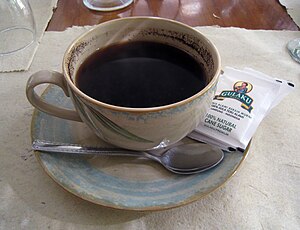
A cappuccino is an espresso-based coffee drink that is traditionally prepared with steamed milk foam (microfoam).

Turkish coffee is a style of coffee prepared in a cezve using very finely ground coffee beans without filtering.
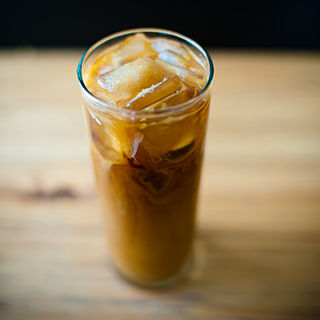
Iced coffee is a coffee beverage served cold. It may be prepared either by brewing coffee normally and then serving it over ice or in cold milk or by brewing the coffee cold. In hot brewing, sweeteners and flavoring may be added before cooling, as they dissolve faster. Iced coffee can also be sweetened with pre-dissolved sugar in water.

Singaporean cuisine is derived from several ethnic groups in Singapore and has developed through centuries of political, economic, and social changes in the cosmopolitan city-state.

A kopitiam or kopi tiam is a type of coffee shop mostly found in parts of Indonesia, Malaysia, Singapore, Brunei and Southern Thailand patronised for meals and beverages, and traditionally operated by the Chinese community of these countries. The word kopi is an Indonesian and Malay term for coffee and tiam is the Hokkien/Hakka term for shop. Menus typically feature simple offerings: a variety of foods based on egg, toast, kaya, plus coffee, tea, Horlicks and Milo.

White coffee can refer to any of a number of different kinds of coffees or coffee substitutes worldwide.

Teh tarik is a popular hot milk tea beverage most commonly found in restaurants, outdoor stalls, mamaks and kopitiams within the Southeast Asian countries of Malaysia, Indonesia, Singapore and Thailand. Its name is derived from the process of repeatedly pouring the drink back and forth from one container into another with arms extended during preparation, which helps to slightly cool the tea for consumption and giving it a frothy head. It is made from a strong brew of black tea blended with condensed milk. It is the national drink of Malaysia.
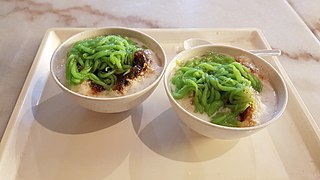
Cendol is an iced sweet dessert that contains droplets of pandan-flavoured green rice flour jelly, coconut milk and palm sugar syrup. It is commonly found in Southeast Asia and is popular in Indonesia, Malaysia, Brunei, Cambodia, East Timor, Laos, Vietnam, Thailand, Singapore, and Myanmar. Next to the green jelly, additional toppings might be added, including diced jackfruit, sweetened red azuki beans, or durian.
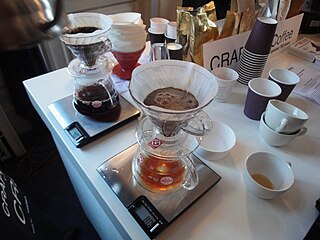
Coffee preparation is the process of turning coffee beans into liquid coffee. While the particular steps vary with the type of coffee and with the raw materials, the process includes four basic steps: raw coffee beans must be roasted, the roasted coffee beans must then be ground, and the ground coffee must then be mixed with hot or cold water for a specific time (brewed), the liquid coffee extraction must be separated from the used grounds, and finally, if desired, the extracted coffee is combined with other elements of the desired beverage, such as sweeteners, dairy products, dairy alternatives, or toppings.

Kue is an Indonesian bite-sized snack or dessert food. Kue is a fairly broad term in Indonesian to describe a wide variety of snacks including cakes, cookies, fritters, pies, scones, and patisserie. Kue are made from a variety of ingredients in various forms; some are steamed, fried or baked. They are popular snacks in Indonesia, which has the largest variety of kue. Because of the countries' historical colonial ties, Koeé (kue) is also popular in the Netherlands.

Milk coffee is a category of coffee-based drinks made with milk. Johan Nieuhof, the Dutch ambassador to China, is credited as the first person to drink coffee with milk when he experimented with it around 1660.

Indonesia was the fourth-largest producer of coffee in the world in 2014. Coffee cultivation in Indonesia began in the late 1600s and early 1700s, in the early Dutch colonial period, and has played an important part in the growth of the country. Indonesia is geographically and climatologically well-suited for coffee plantations, near the equator and with numerous interior mountainous regions on its main islands, creating well-suited microclimates for the growth and production of coffee.

Bajigur is a hot and sweet beverage native to the Sundanese people of West Java, Indonesia. The main ingredients are coconut milk and Aren sugar; usually to add taste, a small amount of ginger and a small pinch of salt. Traditionally fragrant pandan leaves were added, but now often artificial vanilla powder is used. It can also include kopi tubruk, finely pounded coffee.
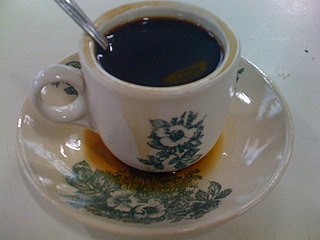
Kopi, also known as Nanyang coffee, is a traditional coffee beverage found in several Maritime Southeast Asian nations. Often brewed to be highly caffeinated in strength, it is commonly served with sugar and/or milk-based condiments. This drink originated from the British Malaya era, with Hainanese cultural roots. The name of the drink is derived from the Malay term for coffee. The term Nanyang, which means "South Sea" in Mandarin, refers to Maritime Southeast Asia. Kopi culture vocabulary is grounded in Hokkien dialect as a result of historical immigration to Maritime Southeast Asia from the Minnan region in the south-eastern part of Fujian Province in Southeastern Mainland China. The beverage is usually served in coffee shops, Hawker centres and kopitiams across the region.

Balinese cuisine is a cuisine tradition of Balinese people from the volcanic island of Bali. Using a variety of spices, blended with the fresh vegetables, meat and fish. Part of Indonesian cuisine, it demonstrates indigenous traditions, as well as influences from other Indonesian regional cuisine, Chinese and Indian. The island's inhabitants are predominantly Hindu and culinary traditions are somewhat distinct with the rest of Indonesia, with festivals and religious celebrations including many special foods prepared as the offerings for the deities, as well as other dishes consumed communally during the celebrations.

An egg coffee is a Vietnamese drink traditionally prepared with egg yolks, sugar, condensed milk and robusta coffee. The drink is made by beating egg yolks with sugar and condensed milk, then extracting the coffee into the cup, followed by a similar amount of egg cream, or egg yolks which are heated and beaten, or whisked.

Gado-gado is an Indonesian salad of raw, slightly boiled, blanched or steamed vegetables and hard-boiled eggs, boiled potato, fried tofu and tempeh, and lontong, served with a peanut sauce dressing.

Acehnese cuisine is the cuisine of the Acehnese people of Aceh in Sumatra, Indonesia. This cuisine is popular and widely known in Indonesia. Arab, Persian, and Indian traders influenced food in Aceh although flavours have substantially changed their original forms. The spices combined in Acehnese cuisine are commonly found in Indian and Arab cuisine, such as ginger, pepper, coriander, cumin, cloves, cinnamon, cardamom, and fennel. A variety of Acehnese food is cooked with curry or coconut milk, which is generally combined with meat such as buffalo, beef, goat meat, lamb, mutton, fish, or chicken.
